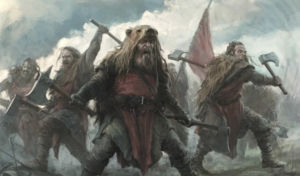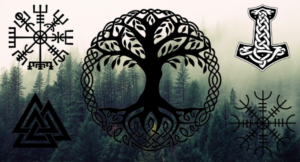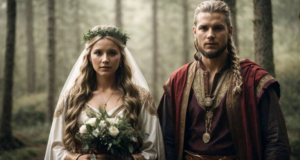In Norse mythology, Yggdrasil, the Tree of Life, stands as a towering symbol of cosmic unity and balance. This immense, evergreen ash tree serves as the axis mundi, connecting the Nine Worlds of Viking cosmology, from the divine realms of Asgard to the shadowy depths of Helheim. Revered in ancient texts like the Poetic Edda and Prose Edda, Yggdrasil embodies the interconnectedness of all existence, sustaining life across realms while hosting mystical creatures. Its profound symbolism—encompassing fate, wisdom, and sacrifice—continues to captivate modern audiences. Why does this ancient tree, rooted in Viking lore, still resonate in our globalised world, inspiring art, literature, and spirituality?
The Mythology Behind Yggdrasil
Yggdrasil’s origins lie in Norse cosmology, detailed in the Poetic Edda and Prose Edda, compiled in the 13th century but drawing on older oral traditions. The name Yggdrasil, often translated as “Odin’s Horse” or “Terrible Steed,” references Odin’s self-sacrifice, where he hung from the tree for nine days to gain the wisdom of runes. As an evergreen ash, Yggdrasil is depicted as a living entity, its branches stretching into the heavens and roots delving into primordial realms. It sustains all life, with sacred wells like Urd’s Well nourishing its roots. The tree’s resilience, surviving cosmic cycles, underscores its role as the backbone of existence, a testament to the Norse view of a dynamic, interconnected universe.
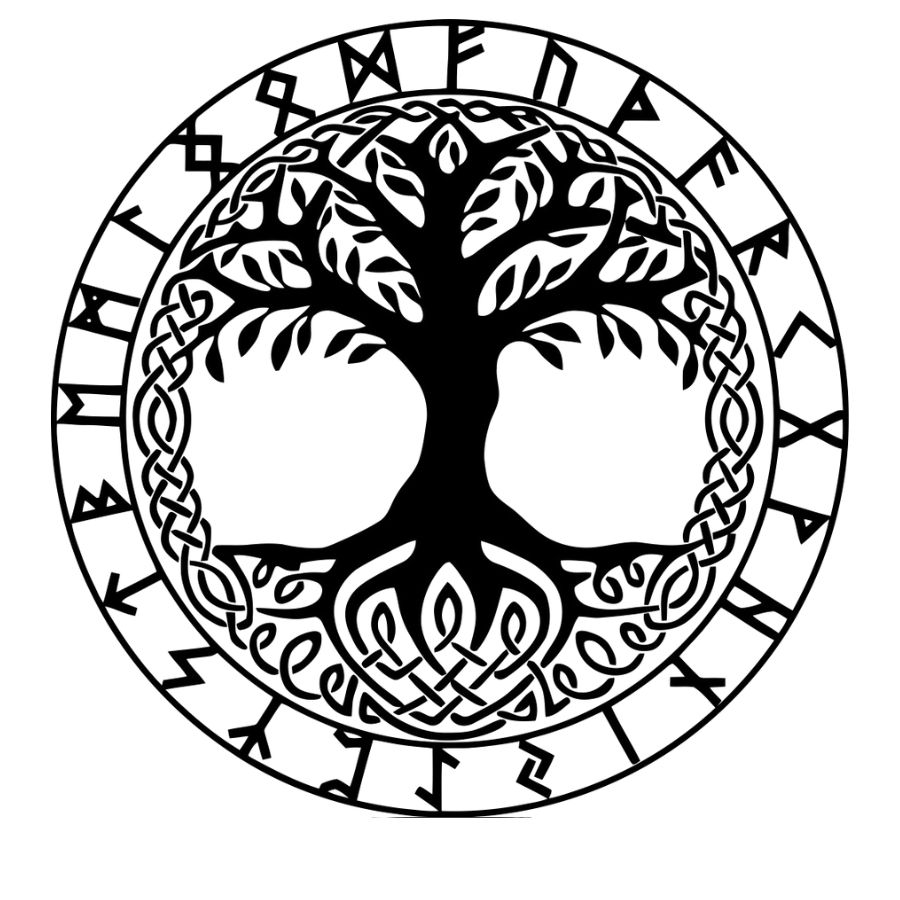
The Structure of Yggdrasil and the Nine Worlds
Yggdrasil’s structure is intricate, its three great roots anchoring it to distinct realms: Asgard (home of the Aesir gods), Jotunheim (land of giants), and Niflheim (realm of ice and mist). These roots draw sustenance from sacred wells, such as Mimir’s Well, associated with wisdom. The Nine Worlds, though not always explicitly listed in surviving texts, typically include Asgard, Midgard (the human world), Jotunheim, Niflheim, Muspelheim (fire realm), Alfheim (elves), Svartalfheim (dwarves), Vanaheim (Vanir gods), and Helheim (the underworld). Each world occupies a unique position within Yggdrasil’s cosmic framework.
The tree teems with life. At its roots, the serpent Nidhogg gnaws, symbolising decay and renewal. Ratatoskr, a squirrel, scurries along the trunk, carrying messages (often insults) between Nidhogg and an unnamed eagle perched at the tree’s apex, with a hawk, Vedrfolnir, resting between its eyes. Four stags—Dain, Dvalin, Duneyr, and Durathror—graze on its leaves, embodying nature’s cyclical balance. This vibrant ecosystem reflects Yggdrasil’s role as a living nexus of creation.
Symbolism and Cultural Importance
Yggdrasil symbolises interconnectedness, with its branches and roots weaving all realms into a unified whole. It embodies fate, as the Norns—goddesses of destiny—reside at its base, shaping the lives of gods and mortals. The tree also represents wisdom, tied to Odin’s sacrifice and the wells of knowledge beneath it. For Vikings, Yggdrasil mirrored sacred groves, where rituals and offerings connected communities to the divine. Archaeological evidence, like the sacred trees at Uppsala, suggests such sites were central to Norse worship.
Yggdrasil shares parallels with world trees in other cultures, such as the Celtic Tree of Life or the Hindu Ashvattha tree, highlighting a universal human fascination with cosmic trees as symbols of unity and eternity. Its enduring appeal lies in its ability to transcend cultural boundaries, offering a timeless metaphor for life’s interdependence.
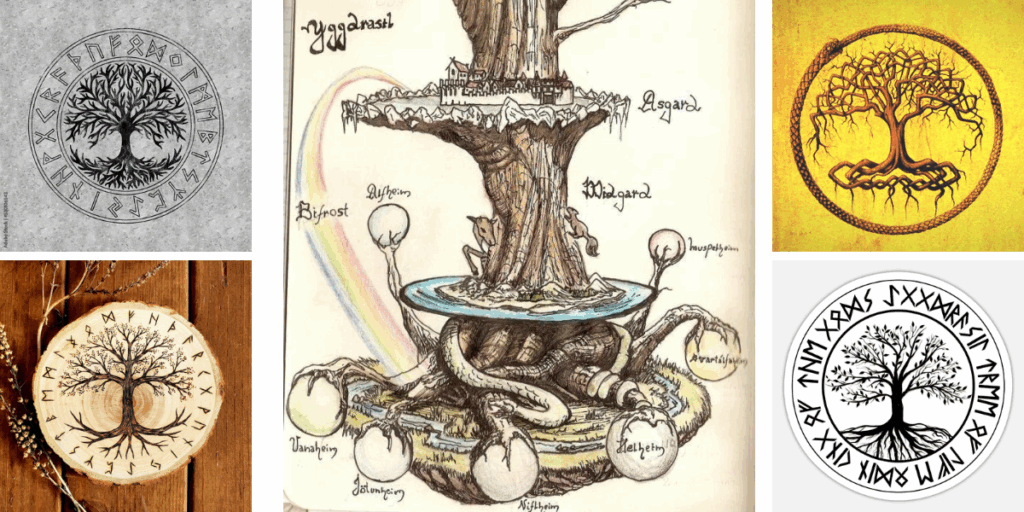
Yggdrasil in Modern Culture
Yggdrasil’s legacy thrives in contemporary culture, particularly in fantasy literature and media. Video games like God of War (2018) and Norse-themed RPGs, such as Assassin’s Creed Valhalla, depict Yggdrasil as a mystical centerpiece, blending myth with immersive storytelling. In literature, authors like Neil Gaiman (Norse Mythology) draw on Yggdrasil to evoke Viking cosmology’s grandeur. The tree’s striking imagery—its vast branches and coiled roots—makes it a popular motif in tattoos, symbolising strength, wisdom, and connection to heritage.
In neo-pagan and New Age communities, Yggdrasil inspires spiritual practices, often interpreted as a symbol of personal growth and universal harmony. Its adaptability ensures its relevance, whether as a mythological icon or a modern emblem of resilience. Social media platforms like X show enthusiasts sharing Yggdrasil-inspired art and jewellery, reflecting its widespread appeal.
Conclusion
Yggdrasil, the Norse Tree of Life, remains a powerful symbol of interconnectedness, wisdom, and cosmic balance. From its mythological roots in the Edda texts to its vibrant presence in modern culture, the tree’s legacy endures, bridging ancient Viking beliefs with contemporary imagination. Its depiction as a living axis, sustaining the Nine Worlds and hosting diverse creatures, resonates with universal themes of unity and renewal. As we navigate an increasingly complex world, how does Yggdrasil’s ancient wisdom inspire us to seek harmony and connection in our own lives?
Download Yggdrasil [FULL HD] [2K]
The Legend of the Berserker Warriors of Northern Europe
Table of ContentsThe Mythology Behind YggdrasilThe Structure of Yggdrasil and the Nine WorldsSymbolism and Cultural
May
The Mystery of the Viking Dreadlocks
Table of ContentsThe Mythology Behind YggdrasilThe Structure of Yggdrasil and the Nine WorldsSymbolism and Cultural
Sep
The Norse Symbol of Ultimate Bravery
Table of ContentsThe Mythology Behind YggdrasilThe Structure of Yggdrasil and the Nine WorldsSymbolism and Cultural
Oct
ODIN – YMIR and Norse Creation Myth
Table of ContentsThe Mythology Behind YggdrasilThe Structure of Yggdrasil and the Nine WorldsSymbolism and Cultural
Apr
The Vikings: Warriors and Explorers of the North Sea
Table of ContentsThe Mythology Behind YggdrasilThe Structure of Yggdrasil and the Nine WorldsSymbolism and Cultural
1 Comment
Mar
Exploring the Mysteries of Viking Wedding Rituals
Table of ContentsThe Mythology Behind YggdrasilThe Structure of Yggdrasil and the Nine WorldsSymbolism and Cultural
Oct


